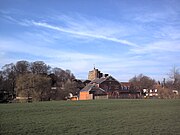Lyminge
| Lyminge | |
|---|---|
 Tayne Field with the Coach & Horses pub and the church in the background |
|
| Lyminge shown within Kent | |
| Population | 2,717 (2011) |
| OS grid reference | TR 161 410 |
| District | |
| Shire county | |
| Region | |
| Country | England |
| Sovereign state | United Kingdom |
| Post town | Folkestone |
| Postcode district | CT18 |
| Dialling code | 01303 |
| Police | Kent |
| Fire | Kent |
| Ambulance | South East Coast |
| EU Parliament | South East England |
| UK Parliament | |
Lyminge is a village in southeast Kent, England. It lies about five miles (8 km) from Folkestone and the Channel Tunnel, on the road passing through the Elham Valley. At the 2011 Census the population of Etchinghill was included. The Nailbourne stream begins in the village and flows north through the Valley, to become one of the tributary streams of the Great Stour. The hamlet of Ottinge lies to the NE on the road to Elham. Lyminge is surrounded by farmland and ancient forests. There is a wide variety of flora and fauna in the surrounding area, including badgers, various species of deer along with wild boar. These are thought to have escaped from farmed populations. Lyminge is home to Sibton Park, now owned by the Holiday Property Bond.
Lyminge currently is home to Sibton Park Cricket Club who play in Division 1 of the Kent Cricket League and have a very active Junior Section which caters for boys and girls from a wide area in and around Lyminge.
The Elham Valley Railway ran from Canterbury to Folkestone through the village from 1887 until eventually closing in 1947. The station building exists today as the library, situated in The Sidings, off Station Road.
Lyminge has been a focus of archaeological work for over a half a century. In December 1953 two inhumation burials were discovered there by workmen working for farming contractors, and subsequent excavations led by Alan Warhurst resulted in the discovery of a 6th-century Jutish cemetery (grid reference TR 1638 4169) containing 44 graves. The grave assemblages were remarkable, although not unusual for this period, and contained a lot of high status jewellery, weapons such as spear-heads, swords and shield bosses and some rare glass claw beakers of exceptional quality and condition.
...
Wikipedia

